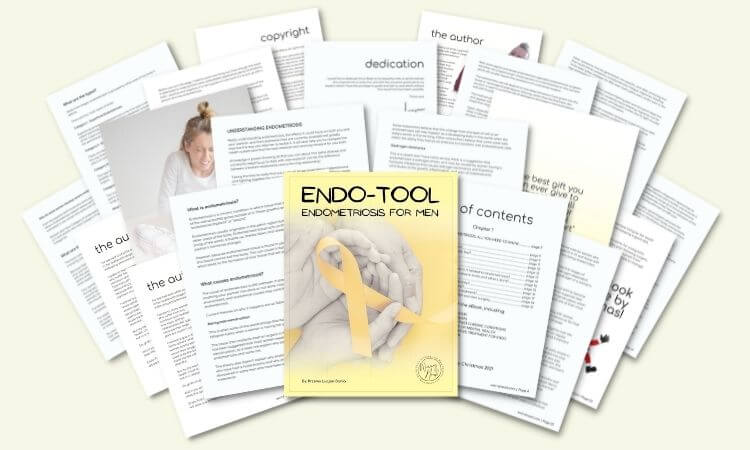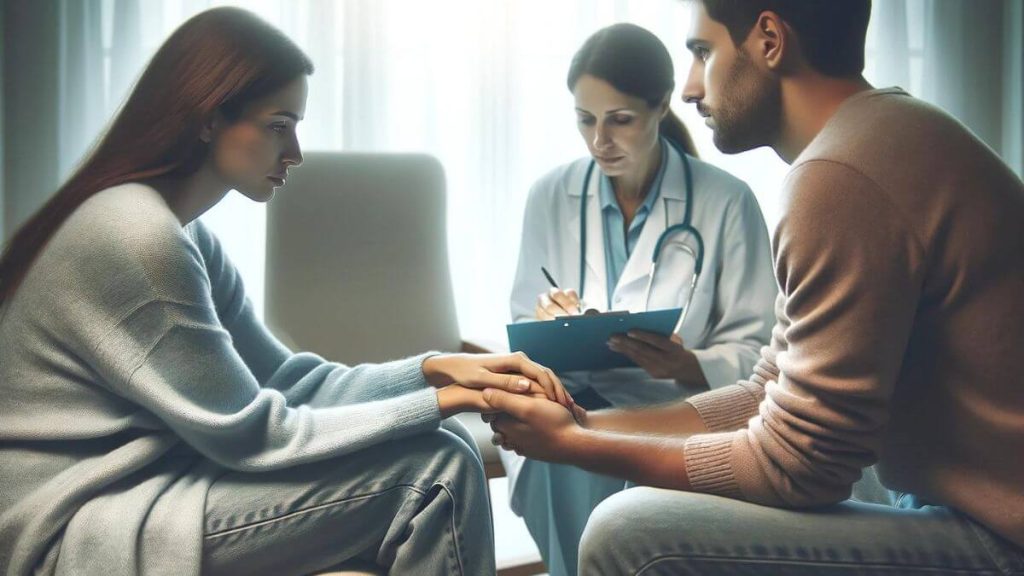Navigating Endometriosis Together as a Couple
As a man deeply devoted to my wife, navigating endometriosis together as a couple has been a journey of understanding, patience, and unwavering support. From accompanying her to doctor’s appointments to researching treatment options together, our bond has only strengthened as we face this challenge as a team.
Navigating Endometriosis Together as a Couple is a crucial aspect of managing this condition, requiring mutual understanding, patience, and support. Couples can enhance their relationship by facing challenges together, attending medical appointments, and researching treatment options as a team. It’s essential to communicate openly, prioritize self-care, and seek professional guidance to navigate the complexities of endometriosis as a couple.
Scroll down to delve deeper into strategies for supporting a partner with endometriosis and strengthening your relationship through shared challenges.
- Navigating Endometriosis Together as a Couple
- How Endometriosis Affects Relationships
- Physical Symptoms of Endometriosis
- Emotional Impact of Endometriosis
- Intimacy and Endometriosis
- Coping Strategies for Couples with Endometriosis
- Impact of Endometriosis on Fertility
- Seeking Medical Treatment for Endometriosis
- Communication and Support
- Managing the Emotional Impact
- Strategies for Maintaining Intimacy
- Nurturing the Relationship
- Seeking External Support
- Balancing Individual Needs
- Enjoying Life Together
- Conclusion on Navigating Endometriosis Together as a Couple
- Source Links
Navigating Endometriosis Together as a Couple
As the husband of a woman who battles both endometriosis and fibromyalgia, I have witnessed firsthand the immense physical and emotional toll these conditions can take on couples. From the relentless pain to the countless doctor’s appointments, everyday life can become a battleground for those affected by these chronic illnesses.
But amidst the challenges and the uncertainty, there is something else that I have come to understand – the power of unity and love. In the face of immense pain, my wife and I have learned to support each other, communicate openly, and navigate the complexities of endometriosis together as a couple.
So, let me ask you: How can you and your partner find solace and strength in the midst of the storm? How do you manage endometriosis as a couple, overcoming the hurdles that come your way?
In this article, I will share insights, strategies, and personal experiences to help you cope with endometriosis as partners. Together, we will explore the impact of endometriosis on relationships, navigate the physical and emotional challenges, and discover ways to strengthen your bond as you weather the storm of this chronic condition.

How Endometriosis Affects Relationships
Living with endometriosis can have a significant impact on relationships, posing various challenges that couples must navigate together. The strain on day-to-day life, financial and emotional burdens, differing treatment views, pain during sex, and the emotional toll on both partners can all contribute to the complex dynamics affected by this condition.
Endometriosis can disrupt the quality of life for individuals and, consequently, their relationships. The chronic pain, fatigue, and other symptoms associated with endometriosis can limit daily activities and prevent couples from fully engaging in their bond.
The financial implications of endometriosis, including medical expenses, time off work, and fertility treatments, can put a significant strain on relationships. These financial burdens can add additional stress and create challenges in effectively managing the condition as a couple.
Views on treatment can also affect relationships, as partners may have differing opinions on the best course of action. It is important for couples to engage in open and honest conversations about treatment options and make decisions together that align with their shared goals and values.
Pain during sex is another common challenge faced by couples affected by endometriosis. The physical discomfort experienced by individuals with endometriosis can hinder sexual intimacy and strain the emotional connection between partners.
The emotional toll of living with endometriosis affects both partners and can further impact the relationship. Feelings of frustration, helplessness, and sadness can arise as individuals cope with the daily challenges of the condition. It is crucial for couples to communicate openly and provide emotional support to one another.
To better understand the impact of endometriosis on relationships, let’s take a closer look at how it affects various aspects of couples’ lives.
Physical Symptoms of Endometriosis
Endometriosis is a chronic condition that can cause a range of physical symptoms, impacting daily life and overall well-being. Understanding and recognizing these symptoms is essential in seeking appropriate medical treatment and managing the condition effectively.
Some of the common physical symptoms of endometriosis include:
- Pelvic pain: Endometriosis often presents with persistent and chronic pelvic pain. This pain can vary in intensity and may be experienced throughout the menstrual cycle.
- Painful periods: Women with endometriosis often experience severe pain during menstruation, referred to as dysmenorrhea. This can make it challenging to carry out regular activities and can significantly impact quality of life.
- Heavy menstrual bleeding: Endometriosis can also cause excessive or prolonged menstrual bleeding. This can lead to increased fatigue and may affect emotional well-being.
These physical symptoms can have a significant impact on daily activities, relationships, and intimacy. It is important to consult with healthcare professionals to diagnose and manage endometriosis effectively. Treatment options may include pain management, hormone therapies, or surgical interventions.
Recognizing and addressing these symptoms can make a significant difference in managing endometriosis and improving overall quality of life.
Below is a table summarizing the physical symptoms of endometriosis…
| Symptom | Description |
|---|---|
| Pelvic pain | Chronic pain in the pelvic region, which may be experienced throughout the menstrual cycle. |
| Painful periods | Severe pain during menstruation, also known as dysmenorrhea. |
| Heavy menstrual bleeding | Excessive or prolonged menstrual bleeding, leading to increased fatigue. |
If you want to learn more about endometriosis, I wrote an “Endo-Tool, Endometriosis for Men” e-Book.
You can get the 1st Chapter of the e-Book for FREE, and if you like it, you’ll get a Whopping 33% Discount on the Whole Book, plus discounts on other helpful tools. You have nothing to lose but a lot to gain!
The first chapter alone contains all the comprehensive medical knowledge about endometriosis, including:
- What is endometriosis?
- What are the symptoms?
- What causes endometriosis?
- What does endometriosis look like?
- What are the stages?
- What are the types?
- What is adenomyosis and how is it related to endometriosis?
- Why do some women develop severe endo and others don’t?
- Does endometriosis cause infertility?
- How is endometriosis diagnosed?
- Do types and stages affect the treatment?
- Recurrence of endometriosis after excision surgery.
FREE Chapter of “Endo-Tool”
Endometriosis e-Book for Men

Emotional Impact of Endometriosis
Living with endometriosis can take a significant emotional toll, affecting not only the individual but also their relationships with loved ones. The constant pain, uncertainty, and disruption to daily life can lead to feelings of isolation, anxiety, depression, and frustration.
Endometriosis often goes beyond physical symptoms, impacting mental health and overall well-being. The invisible nature of the condition can make it challenging for others to understand the emotional burden experienced by those with endometriosis.
For couples, the emotional impact of endometriosis can put a strain on the relationship. It is common for partners to feel helpless, frustrated, and overwhelmed by the challenges they witness their loved one facing. Additionally, the person with endometriosis may feel guilty for burdening their partner and worry about the effect it has on the relationship.
It is crucial to prioritize mental health and seek support when needed. By acknowledging and addressing the emotional impact of endometriosis, individuals and couples can navigate the challenges more effectively.
The Effects on Mental Health
The emotional toll of endometriosis can manifest in various ways, impacting mental health and overall well-being:
- Feelings of isolation: The chronic nature of endometriosis can lead to feelings of isolation, as individuals may struggle to find others who understand their experience.
- Anxiety: The uncertainty surrounding pain, treatment options, and the impact on fertility can contribute to anxiety and constant worry.
- Depression: The ongoing pain, limited physical activity, and disruption to daily life can lead to feelings of sadness, hopelessness, and loss of interest in previously enjoyable activities.
- Frustration: Endometriosis is a complex condition that often does not have a straightforward solution. This can lead to frustration and a sense of powerlessness.
The Impact on Relationships
The emotional impact of endometriosis can also impact relationships, particularly the intimate partnership between a couple:
- Strained communication: The physical and emotional challenges of endometriosis can make it difficult to communicate effectively. Partners may struggle to understand each other’s experiences and emotions.
- Sexual intimacy: Endometriosis can cause pain during sexual intercourse, leading to a decrease in sexual intimacy. This can create feelings of frustration, guilt, and strain on the relationship.
- Emotional support: The person with endometriosis may require additional emotional support from their partner, which can be overwhelming at times. Balancing the emotional needs of both partners is crucial to maintain a healthy relationship.
| Emotional Impact | Examples |
|---|---|
| Feelings of isolation | Withdrawal from social activities, craving connection with others who understand |
| Anxiety | Constant worry about pain, treatment options, and fertility |
| Depression | Feelings of sadness, hopelessness, loss of interest in activities |
| Frustration | Sense of powerlessness, frustration with the complexity of the condition |

Intimacy and Endometriosis
Safeguarding mental health is an essential aspect of managing endometriosis. Seeking professional help from therapists or support groups can provide individuals and couples with the tools and support needed to navigate the emotional impact of endometriosis.
Additionally, open and honest communication between partners can foster empathy, understanding, and strengthen the relationship in the face of this challenging condition.
Living with endometriosis can pose challenges to intimacy and sexual activity for couples. The physical symptoms of endometriosis, such as pain during sex, bleeding, and fatigue, can significantly impact a couple’s sexual relationship. Moreover, the emotional factors associated with this chronic condition, such as anxiety and fear of pain, can further affect intimacy.
However, there are ways for couples to navigate these challenges and maintain an intimate connection. Open and honest communication is essential in understanding each other’s needs and concerns. By discussing fears and discomforts, partners can work together to find alternative forms of intimacy that foster emotional connection and physical pleasure.
Exploring new ways to connect physically and emotionally can help couples maintain intimacy even in the face of endometriosis. This could include engaging in non-sexual activities that bring pleasure and spark connection, such as cuddling, massage, or shared hobbies. Remember, intimacy is not solely defined by sexual activity, but rather, by the emotional bond shared between partners.
It’s crucial for couples to seek appropriate medical treatments for endometriosis, as managing the physical symptoms can contribute to improved intimacy. Consulting with healthcare professionals, such as gynecologists or pelvic pain specialists, can provide valuable insights and potential solutions for pain management during sexual activities.
In addition to medical interventions, emotional support is essential in navigating the impact of endometriosis on intimacy. Seeking professional counseling or joining support groups specifically addressing sexual challenges in endometriosis can provide a safe space to share experiences, learn coping strategies, and receive guidance from experts.
Endometriosis and Intimacy Tips for Couples
- Engage in open and honest communication about sexual needs and concerns.
- Explore alternative forms of physical and emotional intimacy, such as cuddling, massaging, and shared activities.
- Seek appropriate medical treatment for managing endometriosis symptoms that affect intimacy.
- Consider counseling or joining support groups focused on sexual challenges in endometriosis.
- Practice self-care and prioritize emotional well-being to maintain a healthy and fulfilling relationship.
By actively addressing the sexual challenges posed by endometriosis, couples can find ways to maintain intimacy and strengthen their bond. Remember, it’s important to approach these challenges with patience, understanding, and a commitment to supporting each other throughout the journey.
Coping Strategies for Couples with Endometriosis
Living with endometriosis as a couple can be challenging, but there are coping strategies that can help you navigate this journey together. Here are some effective strategies for managing endometriosis as a couple:
- Effective Communication: Open and honest communication is key in understanding each other’s needs and concerns. Take the time to listen and express your emotions, creating a safe space for both partners to share their experiences with endometriosis.
- Seeking Support: Reach out to healthcare professionals who specialize in endometriosis to receive the necessary medical guidance and support. They can provide valuable information on treatment options and help you make informed decisions together.
- Exploring Alternative Treatments: Alongside conventional medical treatments, consider exploring alternative therapies such as acupuncture, yoga, or dietary changes. Discuss these options with your healthcare provider to see if they could complement your treatment plan.
- Practicing Self-Care: Make self-care a priority for both partners. This can include engaging in activities that bring you joy, practicing relaxation techniques, and prioritizing rest and recuperation when needed. Taking care of yourselves individually will strengthen your ability to support each other as a couple.
By incorporating these coping strategies into your daily lives, you can better manage the challenges of endometriosis as a couple. Remember, you are not alone in this journey. Support each other, never hesitate to seek help when needed, and celebrate your resilience as a couple.
| Benefits of Coping Strategies for Couples with Endometriosis |
|---|
| Improved emotional well-being: Effective communication and support can help reduce feelings of isolation and frustration, promoting a stronger emotional connection between partners. |
| Enhanced quality of life: By exploring alternative treatments and practicing self-care, couples can experience a better quality of life, managing physical symptoms and finding joy in their shared activities. |
| Strengthened partnership: Coping strategies foster teamwork and mutual understanding, strengthening the bond between partners as they navigate the challenges of endometriosis together. |

Impact of Endometriosis on Fertility
Endometriosis can have a significant impact on fertility, making it more challenging for couples to conceive. This can create additional stress and strain in relationships, as the desire to have a child may be met with obstacles. Understanding the impact of endometriosis on fertility is crucial in navigating this aspect of the condition.
How does endometriosis affect fertility?
Endometriosis can affect fertility through various mechanisms. The presence of endometrial tissue outside the uterus can cause inflammation, scarring, and the formation of adhesions. These abnormalities can interfere with the normal functioning of the reproductive organs, including the fallopian tubes, ovaries, and uterus.
In addition, endometriosis can disrupt the hormonal balance necessary for ovulation and implantation of a fertilized egg. This hormonal imbalance can result in irregular menstrual cycles, anovulation (lack of ovulation), and the formation of ovarian cysts.
The challenges of conceiving with endometriosis
Couples with endometriosis may face several challenges when trying to conceive:
- Decreased egg quality: The presence of endometriosis can affect egg quality, making it more difficult for fertilization and implantation to occur.
- Blocked fallopian tubes: Adhesions and scar tissue caused by endometriosis can block the fallopian tubes, preventing the egg and sperm from meeting.
- Increased risk of ectopic pregnancy: Endometriosis can increase the risk of ectopic pregnancy, where the fertilized egg implants outside the uterus, usually in the fallopian tube. This can be a life-threatening condition.
- Hormonal imbalances: Endometriosis can disrupt the production and balance of hormones necessary for ovulation and embryo implantation.
Exploring fertility options and support
While endometriosis can pose challenges to fertility, it is essential for couples to explore their options and seek support:
- Fertility treatments: Assisted reproductive technologies, such as in vitro fertilization (IVF), may be recommended for couples with endometriosis. These treatments can bypass the fallopian tubes and help increase the chances of conception.
- Medical interventions: Surgical interventions, such as laparoscopic excision of endometriosis lesions or removal of adhesions, can help improve fertility outcomes for some couples.
- Emotional support: Dealing with infertility and the challenges of conceiving can be emotionally taxing. Seeking support from friends, family, or a support group, and considering counseling, can provide much-needed emotional support and guidance.
It is important for couples to remember that they are not alone in their journey. Many resources, healthcare professionals, and support networks are available to provide guidance and assistance in navigating the challenges of conceiving with endometriosis.
| Treatment Option | Description |
|---|---|
| In vitro fertilization (IVF) | IVF involves fertilizing eggs with sperm in a laboratory setting and then transferring the resulting embryo(s) to the uterus. This bypasses any potential issues with the fallopian tubes. |
| Laparoscopic surgery | Surgery can be performed to remove endometriosis lesions, scar tissue, and adhesions. This can help improve fertility outcomes for some couples. |
| Fallopian tube surgery | If the fallopian tubes are blocked or damaged due to endometriosis, surgery may be performed to repair or unblock them, allowing for increased chances of natural conception. |
| Hormonal therapies | Medications such as gonadotropin-releasing hormone (GnRH) agonists or antagonists can be used to temporarily suppress the menstrual cycle, reduce endometriosis symptoms, and improve fertility outcomes. |

Seeking Medical Treatment for Endometriosis
When it comes to managing endometriosis, medical treatment plays a crucial role in alleviating symptoms and improving overall quality of life. With a variety of treatment options available, it is important to consult with healthcare professionals to determine the most appropriate approach based on your individual needs and goals.
Medical management of endometriosis typically involves a combination of pain management, hormonal therapies, and surgical interventions. Let’s explore each of these options…
Pain Management
Pain management is an essential part of endometriosis treatment. Over-the-counter pain relievers, such as nonsteroidal anti-inflammatory drugs (NSAIDs), can help alleviate menstrual cramps and pelvic pain. In some cases, stronger prescription medications may be necessary to effectively manage pain associated with endometriosis.
Hormonal Therapies
Hormonal therapies aim to regulate hormone levels and reduce the growth of endometrial tissue. Common hormonal treatment options include:
- Birth control pills: These can help regulate the menstrual cycle and reduce symptoms such as cramping and heavy bleeding.
- Gonadotropin-releasing hormone (GnRH) agonists: These medications induce a state of temporary menopause, which can help shrink endometrial tissue and alleviate symptoms.
- Progestin therapy: Progestin, a synthetic form of progesterone, can help suppress the growth of endometrial tissue and reduce symptoms.
Surgical Treatment
In cases where medical management alone is insufficient, surgical intervention may be necessary. Surgical treatment for endometriosis aims to remove or destroy endometrial tissue, and it can be performed using different techniques:
- Laparoscopy: This minimally invasive surgical procedure involves inserting a thin, lighted instrument called a laparoscope into the abdomen to visualize and remove endometrial implants.
- Laparotomy: In more severe cases, a laparotomy, which is a larger abdominal incision, may be necessary to remove extensive endometrial tissue or cysts.
It is important to note that surgical treatment does not guarantee a permanent cure for endometriosis, as the condition can recur. However, it can provide significant relief from symptoms and improve fertility outcomes in some cases.
To determine the best approach for your specific situation, consult with your healthcare professional, who will consider factors such as the severity of your symptoms, your desire for fertility, and your overall health.
| Treatment Option | Description |
|---|---|
| Pain Management | Utilization of over-the-counter or prescription medications to alleviate pain and discomfort associated with endometriosis. |
| Hormonal Therapies | Use of birth control pills, GnRH agonists, or progestin therapy to regulate hormones and reduce the growth of endometrial tissue. |
| Surgical Treatment | Removal or destruction of endometrial tissue through laparoscopy or laparotomy to alleviate symptoms and improve fertility outcomes. |

Communication and Support
In navigating endometriosis as a couple, effective communication is crucial for providing the necessary support to your partner. By openly and compassionately discussing the challenges and emotions associated with endometriosis, both partners can strengthen their bond and alleviate feelings of isolation.
Below are some strategies for fostering effective communication and support…
Be Empathetic
Try to understand and empathize with your partner’s experience of living with endometriosis. Acknowledge their pain, emotional struggles, and challenges, and provide a safe space for them to express their feelings without judgment.
Attend Appointments Together
Accompanying your partner to medical appointments demonstrates your commitment and support. It also allows you to actively participate in discussions about treatment options, ask questions, and offer emotional support during potentially overwhelming situations.
Engage in Decision-making
Involve yourself in the decision-making processes related to your partner’s endometriosis treatment. Discuss the various options together, weigh the pros and cons, and make well-informed decisions as a team. This ensures that both partners have a say in the treatment plan and feel supported throughout the journey.
Validate Emotions
It is natural for your partner to experience a range of emotions due to endometriosis. Validate their feelings and provide reassurance that their emotional responses are valid. Offer a listening ear and avoid minimizing or dismissing their emotions.
Be Patient and Flexible
Endometriosis can be unpredictable, and symptoms may vary from day to day. Practice patience and flexibility in adapting to your partner’s changing needs. Offer understanding when plans need to be adjusted or when certain activities may become challenging for them.
Seek Outside Support
Don’t hesitate to seek outside support when needed. Joining support groups with other couples facing similar challenges can provide a sense of community and shared experiences. Additionally, professional counseling can offer valuable guidance and coping strategies for both partners.
Remember, by prioritizing effective communication and providing emotional support, you can navigate the challenges of endometriosis together as a strong and resilient couple.
Managing the Emotional Impact
Living with endometriosis can have a profound emotional impact on both partners in a relationship. Managing these emotions is crucial for maintaining a healthy and supportive partnership. Here are some strategies to help cope with the emotional challenges of endometriosis:
- Acknowledge and address your own emotions: It’s important to recognize and validate your own feelings about the impact of endometriosis on your life. Whether it’s frustration, sadness, or fear, allowing yourself to acknowledge and express these emotions can be a powerful first step towards managing them.
- Seek external support if needed: Sometimes, talking to someone outside of your relationship can provide a fresh perspective and additional support. Consider reaching out to a therapist, counselor, or joining a support group specifically for partners of individuals with endometriosis.
- Practice self-care: Taking care of your own emotional well-being is essential. Engage in activities that bring you joy and help you relax. This can include exercise, meditation, hobbies, or spending quality time with friends and loved ones.
By acknowledging your emotions, seeking support, and practicing self-care, you can better navigate the emotional impact of endometriosis as a couple and maintain a strong and supportive relationship.

Examples of Coping Strategies
| Strategy | Description |
|---|---|
| Communication | Regularly communicate with your partner about your emotions, concerns, and needs. Create a safe space for open dialogue. |
| Active Listening | Show empathy and understanding by actively listening to your partner’s thoughts and feelings without judgment or interruption. |
| Shared Activities | Engage in activities that you both enjoy to maintain a sense of connection and togetherness. |
| Support Network | Build a support network of friends, family, or support groups who can provide emotional support and understanding. |
| Seek Professional Help | If needed, consider seeking professional help from therapists or counselors who specialize in relationships or chronic illness. |
Strategies for Maintaining Intimacy
When living with endometriosis, maintaining intimacy in your relationship can be challenging. The pain and other symptoms associated with the condition may affect your sexual activity, but it doesn’t mean you have to give up on intimacy altogether.
By exploring alternative forms of physical and emotional connection and fostering open communication, you can overcome these challenges and maintain a strong bond with your partner.
Alternative Forms of Intimacy
Intimacy extends beyond sexual activity. While physical intimacy may be limited due to endometriosis-related pain, there are alternative ways to foster closeness and connection with your partner.
Consider engaging in non-sexual activities that promote emotional intimacy, such as cuddling, kissing, or giving each other massages. These actions can provide comfort and strengthen your emotional bond, even if sexual activity is temporarily on hold.
Additionally, engaging in shared hobbies or interests can help you stay connected and have fun together. Whether it’s watching movies, playing board games, or taking walks, finding activities that you both enjoy can create opportunities for quality time and deepen your connection.
Open Communication and Understanding
Open communication is key to maintaining intimacy in the face of endometriosis-related challenges. Discuss your feelings, concerns, and any physical limitations or discomfort you may be experiencing. This can help your partner understand your needs and provide the support you require.
Be patient with each other and practice empathy. Understand that your partner may also be navigating their own emotions and frustrations. By being understanding and supporting each other, you can create an atmosphere of trust and intimacy.

Seeking Professional Help
If you find that maintaining intimacy is particularly challenging, consider seeking professional help. A therapist or counselor experienced in working with couples facing chronic illnesses like endometriosis can provide guidance and support. They can help you navigate the emotional and physical aspects of the condition, and offer strategies to enhance intimacy and strengthen your relationship.
| Strategies for Maintaining Intimacy in Endometriosis | Benefits |
|---|---|
| Exploring alternative forms of physical and emotional connection | – Provides closeness and comfort – Strengthens emotional bond |
| Open communication and understanding | – Fosters trust and support – Helps meet each other’s needs |
| Seeking professional help | – Offers guidance and strategies – Enhances intimacy and relationship |
Nurturing the Relationship
Living with endometriosis can present unique challenges for couples, but it can also provide an opportunity to strengthen your relationship. By nurturing your partnership through open communication, mutual support, and engaging in shared activities, you can cultivate a supportive environment that helps you navigate the ups and downs of living with endometriosis together.
One important aspect of nurturing your relationship is to make quality time for each other. Despite the demands of managing endometriosis, prioritize spending dedicated time together. This can involve going on regular date nights, planning weekend getaways, or simply enjoying a quiet evening at home. By intentionally carving out time for each other, you can deepen your connection and reinforce your partnership.
Engaging in shared activities is another way to nurture your relationship. Find hobbies or interests that you both enjoy and make an effort to participate in them together. This could be anything from hiking, cooking, or attending concerts to practicing yoga or painting. By sharing experiences and pursuing common interests, you can create cherished memories and reinforce your bond.
Maintaining a positive outlook is crucial when facing the challenges of endometriosis. It is essential to focus on the strengths and positive aspects of your relationship rather than dwelling solely on the difficulties.
Celebrate small victories together and remind yourselves of the love and support that you provide for each other. Keeping a positive mindset can help you navigate the tough times and foster resilience in your relationship.
Building a Supportive Environment
Building a strong partnership in the face of endometriosis also involves creating a supportive environment. This means actively listening to each other’s concerns, validating emotions, and offering empathy and understanding. When one partner is going through a tough time, the other can step in to provide comfort and reassurance.
It is important to communicate openly and honestly about how endometriosis is impacting your individual lives and your relationship as a whole. Discussing challenges, fears, and frustrations can help foster a sense of mutual understanding and provide a platform for problem-solving together. Remember, you are in this journey as a team, and addressing difficulties openly can help fortify your connection.
Seeking support from the endometriosis community or professional counseling can also be beneficial. Connecting with others who are going through similar experiences can provide valuable insight, guidance, and emotional support. Professional counseling can offer strategies to effectively manage the impact of endometriosis on your relationship and overall well-being.

Activities to Nurture Your Relationship
| Shared Activities | Benefits |
|---|---|
| Going for walks or exercising together | Fosters physical and emotional well-being while enjoying quality time |
| Taking up a new hobby or class together | Expands shared experiences and encourages growth as a couple |
| Planning and cooking meals together | Promotes collaboration and strengthens communication |
| Attending support groups or endometriosis events | Provides opportunities for connection, empathy, and shared understanding |
| Practicing mindfulness or meditation together | Promotes stress reduction and emotional well-being as a couple |
Seeking External Support
When navigating the challenges of endometriosis as a couple, seeking external support can be highly beneficial.
This support can provide valuable insights, strategies, and emotional assistance in managing the impact of endometriosis on your relationship. Joining support groups for endometriosis allows you to connect with others who are going through similar experiences, fostering a sense of community and understanding.
These groups often provide a safe space to share your feelings, gain advice, and learn coping mechanisms from others facing similar challenges.
Furthermore, professional counseling can also be immensely helpful.
A qualified counselor or therapist can provide guidance and support specifically tailored to the unique needs of couples navigating endometriosis. They can help you develop effective communication skills, explore coping strategies, and address any emotional challenges that arise.
Professional counseling offers a structured and confidential environment where you can openly discuss your concerns, fears, and goals, ultimately strengthening your relationship and equipping you with the tools to navigate endometriosis together.
By seeking support from both support groups and professional counseling, you can gain insight, validation, and encouragement. Remember, you don’t have to navigate endometriosis alone. There are resources available to help you and your partner on this journey.
Balancing Individual Needs
When navigating endometriosis as a couple, it is crucial to find a balance between the individual needs of each partner and the overall well-being of the relationship. Each person’s experience with endometriosis is unique, and acknowledging and respecting these individual needs is essential for building a healthy and supportive partnership.
Self-care plays a crucial role in maintaining individual well-being and managing the challenges of endometriosis. Taking time for oneself, engaging in activities that bring joy and relaxation, and prioritizing physical and emotional health are important aspects of self-care for both partners.
By recognizing the value of self-care and supporting each other in prioritizing personal well-being, couples can create a strong foundation for managing endometriosis together.
Setting boundaries is another vital component of balancing individual needs. Endometriosis can be physically and emotionally demanding, and it is essential for partners to communicate their limitations and establish boundaries to protect their well-being.
This may involve establishing quiet time for rest, negotiating responsibilities and tasks, or openly discussing the impact of endometriosis on daily life. By setting and respecting boundaries, couples can create a safe and supportive environment for both partners to thrive.
Respecting each other’s emotional and physical well-being is paramount in maintaining a healthy relationship while living with endometriosis. This involves actively listening to each other’s needs, offering understanding and support, and practicing empathy and patience.
Recognizing that both partners may have different coping mechanisms and emotional responses to endometriosis is essential for fostering a compassionate and supportive partnership.
By balancing individual needs with the demands of endometriosis, couples can create a harmonious and supportive relationship, where both partners feel seen, heard, and understood. Prioritizing self-care, setting boundaries, and respecting each other’s emotional and physical well-being are vital steps in navigating the challenges of endometriosis together.
| Individual Needs | Actions |
|---|---|
| Physical well-being | Both partners prioritize self-care activities such as exercise, healthy eating, and rest to manage physical symptoms. |
| Emotional support | Couples actively listen, engage in open conversations, and provide emotional support based on individual needs. |
| Managing stress | Partners work together to identify stress triggers and implement stress-management techniques that work for them individually and as a couple. |
| Communication | Both partners practice open and honest communication, expressing their needs and concerns while actively considering the other’s perspective. |

Enjoying Life Together
Living with endometriosis can be challenging, but it doesn’t mean you can’t find joy and fulfillment in life. Despite the obstacles that come with this chronic condition, couples can focus on the positive aspects and create a fulfilling life together.
One way to find joy in spite of endometriosis is by pursuing shared interests and hobbies. Whether it’s cooking together, going for walks in nature, or exploring a new hobby, engaging in activities that bring you both joy can strengthen your bond and create new positive experiences.
Celebrating small victories along the way is also important. Acknowledging and rejoicing in the little wins, such as managing pain better or finding effective treatment options, can boost your spirits and help you stay positive amidst the challenges.
Building a strong and resilient partnership is key in navigating the journey of endometriosis. By supporting each other emotionally and being there through the ups and downs, you can face the challenges together and find solace in knowing that you have each other’s backs.
Finding Joy in Everyday Moments
Living with endometriosis can make you appreciate the simple joys in life even more. It’s important to focus on the here and now, cherishing the moments of happiness and gratitude.
Take time to savor a delicious meal together, enjoy a beautiful sunset, or have a cozy movie night. These small moments of joy can provide a reprieve from the difficulties and remind you of the happiness that exists amidst the challenges.
Remember, living with endometriosis doesn’t define your entire life. You have the power to create a fulfilling and joyful life with your partner, one beautiful moment at a time.
| Ways to Enjoy Life with Endometriosis |
|---|
| Pursue shared interests and hobbies |
| Celebrate small victories |
| Build a strong and resilient partnership |
| Focus on the present and find joy in everyday moments |
Conclusion on Navigating Endometriosis Together as a Couple
Navigating endometriosis as a couple can be challenging, but it is not impossible. Effective communication, understanding, and support are key in overcoming the physical, emotional, and relational impacts of this chronic condition.
Building a resilient partnership starts with open and compassionate communication. By truly listening to each other’s experiences and needs, couples can create a safe space for expressing emotions and concerns. It is important to remember that no two journeys with endometriosis are the same, and individual experiences may vary.
Seeking appropriate medical and emotional support is essential for managing endometriosis together. Consulting healthcare professionals who specialize in endometriosis can provide valuable insights and treatment options. Additionally, seeking support from support groups or professional counseling can offer a safe haven for sharing experiences, gathering strategies, and receiving emotional support.
Remember, you are not alone in this journey.
Supporting a partner with endometriosis involves empathy, patience, and understanding. By navigating endometriosis together as a couple, you can build a stronger bond and overcome the challenges that this condition brings.
With love, support, and effective management strategies, couples can find hope and resilience in the face of endometriosis.


About Me
Hi, I’m Lucjan! The reason why I decided to create this blog was my beautiful wife, who experienced a lot of pain in life, but also the lack of information about endometriosis and fibromyalgia for men…
